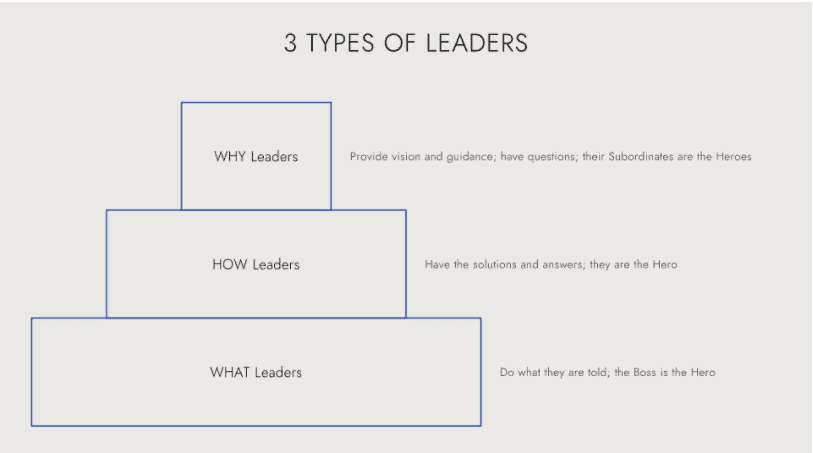3 Types of Leaders you need to know: Are you a WHAT, HOW, or WHY leader?
Only one type of leader creates sustainable growth and inspires people to contribute their best to the team’s success.
The WHAT Leader
WHATs do what the boss tells them to do. They get a task or mission from the boss, organize their team, and get the job done according to the company’s standard operating procedures. WHATs tend to be good first-line leaders — they execute specific tasks and come back for more.
The boss is the hero. The boss makes it rain and tells the WHATs how to do the job.
WHATs do not innovate and tend not to think for themselves outside the confines of carefully delineated boundaries. The best ones take care of their people, ensuring they have the tools and skills to do the job safely and to standard.
WHATs succeed as long as the boss is present to explain what and how to do it. Promote them into a position where they have to develop the plans, and WHATs will struggle.
The HOW Leader
HOWs have the answers and the secret sauce. Their employees look to them for the master plan. HOWs are comfortable with autonomy and don’t like being told how to do their jobs. HOWs can be effective department heads and CEOs as long as the task is within their realm of expertise.
The HOWs set themselves up to be heroes because they have the solutions and plans. They tell people what to do and how to do it. As long as you comply with the HOWs, you are good to go. HOWs tend to strike down innovation because it threatens their hero status.
HOWs succeed as long as they are in their comfort zone but struggle in environments that exceed their expertise.
Some of them will try to be the hero anyway and fail miserably, like J.C. Penny’s Ron Johnson, who brought his HOW from Apple and nearly destroyed the aging retailer. The volcanic rise and meteoric crash of Adam Neumann’s WeWork became the subject of We Crashed, a docu-drama. Some HOWs get consumed by imposter syndrome when they recognize the impossibility of being the hero in a new context.
HOWs fail in a competitive marketplace because they cannot keep pace with innovation. The playbook works well in a static environment but not in a dynamic one. Because the HOW must be the hero, there can be only one authoritative source of ideas. Everyone else gets thrown under the bus. Blockbuster could not adapt when Netflix changed the game. Sony believed its hype about the digital walkman and got trounced by the iPod.

WHY Leaders
WHY leaders are the ones with the questions, they provide guidance and purpose and let their subordinates figure out the how. WHYs have elasticity; they grow into new jobs and environments because growth and innovation are not dependent upon them having the answers.
Their subordinates are the heroes. By inspiring people to contribute their best to the team’s success, WHYs can serve in various contexts. WHYs do not tie their ego to their own particular plans, systems, or ideas.
WHYs are comfortable in their own skin, so they can pass the credit for success to their subordinates and take the heat when something goes wrong. Having everyone’s back encourages risk-taking and innovation. Clarity about the purpose and direction of the organization reduces the likelihood that people will go 100-miles-per-hour in the wrong direction. They practice empathy and use trusted advisors to avoid getting high from their own fumes. WHYs habitually grow their imaginations and develop their subordinates.
In his initial run at Apple, Steve Jobs was a HOW, and the board ousted him as the CEO. He learned from those and subsequent experiences and became a WHY leader, making Apple one of the world’s most successful companies. Jobs prepared his successor, Tim Cook, to take the company to new heights.
Eisenhower was criticized by HOW leader contemporaries for not being more like them. British Field Marshall Montgomery dismissed him as a “Nice chap, no soldier.” Patton and Bradley criticized him for being too lenient on the British. Eisenhower’s WHY leadership promoted the innovation, teamwork, and strategic thinking needed to win the war in Europe.
Becoming a WHY Leader
You become a WHY leader by practicing six habits:
- 1. Be true to yourself. Authenticity is the opposite of selfishness. Impulse is not a permission slip (ask the former Uber CEO). Since there’s no single leadership ideal, be your best you.
- 2. Trust Principles Over Rules. Trustworthiness, Respect, and Stewardship point out true north involatility and uncertainty.
- 3. Practice Empathy, Not Sympathy. Pity is demeaning. Seeing and feeling an issue from someone else’s point of view is your bridge to cooperation.
- 4. Pass the Credit, Take the Hit. Throw people under the spotlight, not under the bus, so that you empower people to innovate and take risks.
- 5. Describe The Why; Delegate The How. Describe what to do and the outcomes you want to achieve. Let your subordinates figure out how to do it, so they have ownership.
- 6. Multiply Your Experiences. You don’t create new wins with status quo thinking. To think outside the box, you must expand your box.
What action steps are you taking to build WHY leaders in your company? Please share in the comments below.










